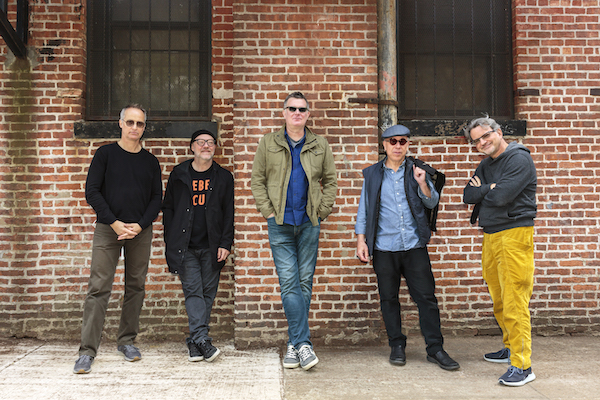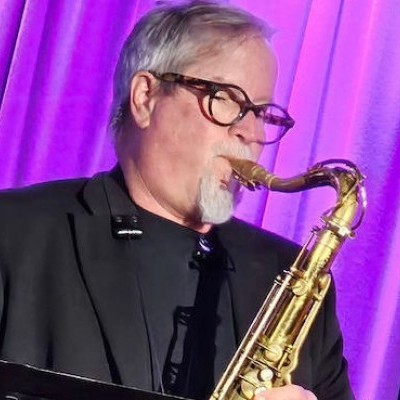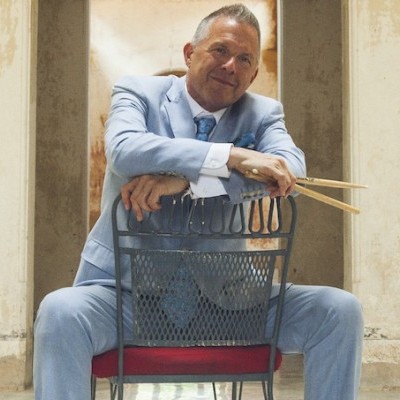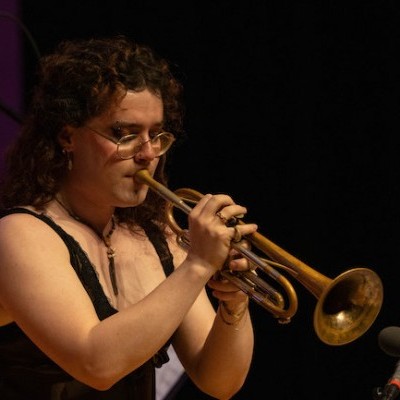Oct 28, 2025 10:47 AM
In Memoriam: Jack DeJohnette, 1942–2025
Jack DeJohnette, a bold and resourceful drummer and NEA Jazz Master who forged a unique vocabulary on the kit over his…

Fiedler and crew return for a second batch of rearranged, reharmonized Sesame Street tunes. From left: Michael Sarin, Sean Conly, Fiedler, Steven Bernstein and Jeff Lederer.
(Photo: Scott Friedlander)With Fuzzy And Blue — his second volume of Sesame Street songs following the 2019 release of Open Sesame — trombonist, composer and arranger Joe Fiedler merges his longstanding day job and his moonlighting projects. As assistant musical director of the Emmy-, Grammy- and Peabody Award-winning children’s TV show since 2009, Fiedler is intimately acquainted with Elmo, Big Bird, Oscar the Grouch and such Sesame Street staples as “Rubber Duckie,” “People In Your Neighborhood” and “I Love Trash.”
As player-bandleader of his own trio, Fiedler leans more toward the avant-garde stylings of his trombone role model Albert Mangelsdorff, whom he paid tribute to on his 2005 Clean Feed recording, and his mentor Ray Anderson, whose sly sense of humor in the music and animated plunger style he incorporates into his own playing.
On Fuzzy And Blue, Fiedler brings the two wildly divergent aspects of his musical life together alongside fellow musical renegades Jeff Lederer on saxophones, Steven Bernstein on trumpet, Sean Conly on bass and longtime collaborator Michael Sarin on drums.
Fieldler got to Sesame Street taking the long way via Broadway. A veteran of the Latin music circuit, he played with Celia Cruz, Willie Colon and Ralph Irizarry while also holding the trombone chair in Eddie Palmieri’s band for the past 15 years. But when Fiedler performed in the original Broadway stage production of Lin-Manuel Miranda’s musical In the Heights, he met Bill Sherman, who later became music director for Sesame Street, bringing the trombonist onboard in 2009. (Fiedler also orchestrated all the horn parts and played lead trombone on the recent filmed adaptation of In the Heights.)
While Fuzzy And Blue celebrates Sesame Street composers Joe Raposo and Jeffrey Moss, not all of the songs on this second volume were actually from the children’s show that ran on PBS from 1969 to 2015 and currently airs on HBO Max. As Fiedler explained, “When Sesame Street first exploded in ’71 to ’72, it was such a national sensation that they started selling toys and merch for the first time. But there was such a demand that they couldn’t keep up with it, so they started making records, too. One was a record called Grover Sings The Blues, which Raposo wrote nine tunes for. ‘I Am Blue’ from that record was never even on the TV show, but I just thought it was such a cool tune that I decided to include it here.”
Kermit the Frog’s iconic “Bein’ Green” (famously covered by Ray Charles, Frank Sinatra, Lena Horne and Van Morrison) was originally on Fiedler’s list for the first album, but he struggled with an arrangement. “The question for me became, ‘How do I find my own voice within this material?’ I wanted to have my own take that was out of the realm where it usually lives, but I couldn’t quite find a good way into it then. So, I set it aside and came back around to it for this second recording.” His answer was to enliven the often melancholy tune by slapping a calypso feel on it. “I wanted to give it a little more spice, more rhythmic life. So the kind of Caribbean vibe was really my way in.”
Elsewhere on Fuzzy And Blue, Fiedler and his flexible crew play a second-line groove on the title track and summon a Hugh Masekela-inspired South African vibe on “Lady Bug’s Picnic.” Bernstein pulls out his slide trumpet on “X Marks The Spot,” which alludes to the spiritual “Wade In The Water,” and Fiedler writes Stravinsky-like voicings for “We Are All Earthlings” while turning “Captain Vegetable” into a kind of march meets a tango.
“I reharmonized most of the tunes, just to take them out of their typical context,” he said. “And it’s funny because even though I’ve written 150 original tunes, and I arrange and orchestrate all day long for Sesame Street and other projects, I’ve never really focused on orchestrating and arranging on my own records. They’re more just blowing kind of situations. So I really took my time on the arrangements on this one. And the pandemic helped me with that because there were no gigs, so I could really suss out the right harmony, the right energy and the right mood on each piece.
“It was fun just digging into the nuances of all the harmony because these Sesame Street tunes are really just like Tin Pan Alley tunes,” he added. “Joe Raposo and Jeffrey Moss wrote prolifically. They were just cranking out tunes on that show. So many great songs.” DB

Jack DeJohnette boasted a musical resume that was as long as it was fearsome.
Oct 28, 2025 10:47 AM
Jack DeJohnette, a bold and resourceful drummer and NEA Jazz Master who forged a unique vocabulary on the kit over his…

“I’ve told students, ‘I don’t mind if you use AI for this or that project,’” says MIT’s Pascal Le Boeuf. “‘But you need to tell me.’”
Sep 18, 2025 11:14 AM
A standard joke when it comes to discussing artificial intelligence, or AI, is that it’s developing so rapidly that…

Chuck Manning Works for NASA … and plays jazz.
Sep 18, 2025 11:23 AM
Congratulations! After years of study, you’ve earned your degree in jazz performance. But let’s face it: Making a…

Always a sharp dresser, Farnsworth wears a pocket square given to him by trumpeter Art Farmer. “You need to look good if you want to hang around me,” Farmer told him.
Sep 23, 2025 11:12 AM
When he was 12 years old, the hard-swinging veteran drummer Joe Farnsworth had a fateful encounter with his idol Max…

“Make time and energy to meet people and make friends,” suggests Millie Ahearn, a student at DePaul University.
Sep 18, 2025 11:32 AM
For many students, the transition into a collegiate jazz program can feel overwhelming — new peers, unfamiliar…